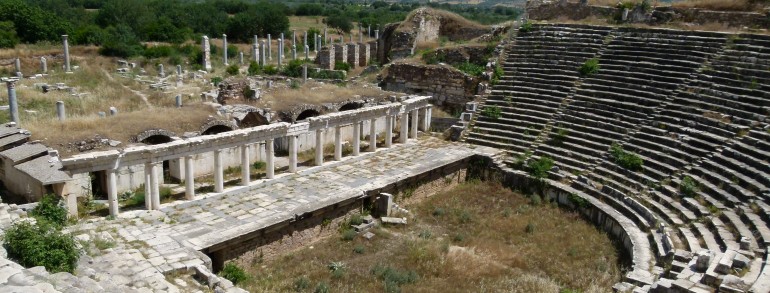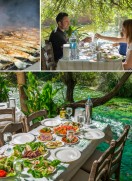Aphrodisias is, in my opinion, one of the most stunning sites in Turkey.
It covers probably a similar area to Ephesus, and has some wonderful buildings, including the fabulous stadium. It is very easy to walk around (though it is quite a long, un-shaded walk), and you will share every building / structure with no more than a couple of other people . This comment is, of course, based on the premise that you have stayed in bed too long like us, not sure what it is like in the morning.
The other big difference is that Aphrodisias is inland, and thus surrounded by mountains. The flip side of the lack of tourism (or the lack of a mention in the bible?) is the lack of investment in archaeology. Although some of the structures have been excavated / restored (some a while ago and very poorly), the vast majority are as they were – but this does let your imagination run wild, and enables you to see many things that maybe otherwise you would miss if they had been rebuilt, such as the hypocaust tiles.
There are plans to eventually turn Aphrodisias into a site to rival Ephesus – but although some work is taking place, under the auspices of the Universities of New York and Oxford, there is little sign of the major investment that would be needed to make this happen. Nevertheless, go soon, just in case!
Facilities are OK here, but limited. There is a café as you enter the site, which is fine for drinks, but don’t plan on dining here (due to lack of choice not hygiene).
Here you can also find the only toilets – and as I said, this is a long walk round!
The museum is also sited near the entrance – and whilst it is tempting to say leave this nice cool place until last, by the time you have walked round, you will probably be ‘statued out’, and just want a cold drink and an ice cream, so I would suggest you do visit first if only briefly. There are some great statues, and it does help to put the whole site in its historical context.
Behind the museum, a large excavation is taking place (August 2006). A depot is being dug out, with the eventual aim of turning this into a display area for the marble friezes from the Sebasteion.
There is an obvious path clockwise round the site, with various diversions as you see things that take your fancy. The first obvious site, off to your right, is the Sebasteion – a temple with what was obviously once multiple storeys, and fantastic friezes. What once appeared to be plans to ‘rebuild’ this now seem to be superseded by the idea of a separate display behind the museum.
The next major structure is the amphitheatre. This is very well preserved, including the stage and like most of these, it is easy to sit and imagine the shows that must have taken place, over 2000 years ago.
From here, walk down to the stage, and then ‘backstage’ through to the Tetrastoon (square / meeting place), much of the floor of which is still intact, and next to which is the theatre baths complex. This is fascinating to walk round, you can still see the ancient pipework, and much of the marble tiling, and can easily imagine it in its ancient glory, thronged with people.
The bad news, you then need to go back through the theatre, and climb up the ranks of seats to the top.
In front of you now is the agora. From the theatre you are significantly above it, walk down and round, and enter through the Portico of Tiberius. It is well worth then walking along the edge of the agora by the columns, many still standing, noting the graffiti (ancient ‘board games’, the occasional Chi/Rho symbol) under your feet, and the interesting gargoyles, back to the other end where there is a beautiful pond. Be careful – at the right time of year, what at first looks like leaves blowing around is actually hundreds of frogs hopping across the path!
Retrace your path through the agora, and enter the baths of Hadrian (sometimes roped off – your decision!)
If it is accessible, then this is really worth exploring, as under the floor is clearly visible the whole system that heated the baths, with original tiles stacked up still.
I walked round here with my brother-in-law, who does a lot of building work. This was fascinating, as he was able to point out a lot of the building intricacies that I would otherwise have missed. It is an interesting point as to how much building technology in Turkey has developed over the years. If you look at some of the half built structures that you see, you may well feel it has gone backwards!
From the baths, follow the path round to the Bouleuterion / Council House / Bishop’s Palace. This has now reopened after extensive restoration, enabling you to fully appreciate the 1750 seat auditorium.
Climb to the top row of seats, exit through the back, and walk down to the Temple of Aphrodite. This interesting building has a long history – it started life as a pagan temple in the 1st Century BC, and 600 years later was turned into a Christian cathedral, which it remained for another 600 years.
From the temple, head off down the path to the stadium (some 200m away). This is possibly the most impressive structure I have ever seen in Turkey. Set well away from the main city, it is in wonderful condition, and, like the theatre, it is possible to sit here for hours and just imaging the ancient races that must have taken place. And you can probably do this in utter solitude. (As an aside, all these photos were taken in the 3rd week of August, early to mid afternoon – compare them to the crowds in the Ephesus photos, taken at a similar date / time).
From the stadium, walk back towards the city.
The last major site is the Tetrapylon, an original 2nd century gateway. This has been rebuilt fairly recently (boards near the structure tell the story of the reconstruction, and also of the archaeologist, buried nearby, who spent much of his life at Aphrodisias). Due to the desire to keep the grass green, there are usually some sprinklers here – and the only queue you will see all day is people running around under these trying to cool down!
From Akyaka, take the Mugla road, and then at the main Mugla traffic lights take the E330 towards Denizli. Follow this road up and around mountains and across plains (it is a very scenic journey) until just as you get to Tavas, where is a set of traffic lights with Aphrodisias signposted off to the left. It is about 35km from here. Total distance is approximately 175 kms, allow 2.5 to 3 hours by car.
Once you reach the site, and depending on time, if you wish to eat, continue on, and you will find restaurants on the left within a km or so (a particular favourite is the Anatolian). Although they cater primarily for coach parties, the food is good, and you will get served quickly.
Aphrodisias is not actually very far from Pammukkale, probably less than an hour. However, unless you plan to stay over, my advice would be to not try to do both in one trip – either of these sites justifies a whole day in its own right, and to fit both into one day would not do justice to either.
Further Details












